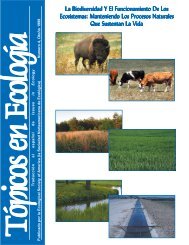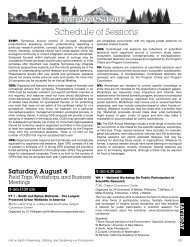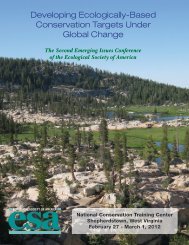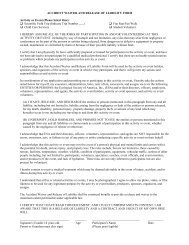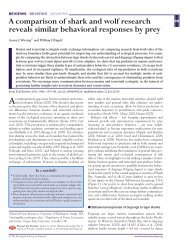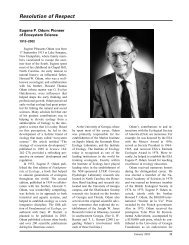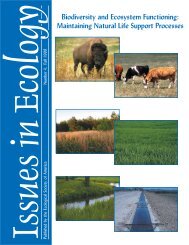Printed Program (PDF) - Ecological Society of America
Printed Program (PDF) - Ecological Society of America
Printed Program (PDF) - Ecological Society of America
You also want an ePaper? Increase the reach of your titles
YUMPU automatically turns print PDFs into web optimized ePapers that Google loves.
8 am-11:30 am<br />
nitrogen transformations by applying spatiotemporal<br />
variability in a semi-arid agricultural stream.<br />
8:20 AM COS 126-2 Ruan, L and GP Roberston, Michigan State<br />
University. Non-linear nitrous oxide (N2O) response to N<br />
fertilizer during switchgrass establishment.<br />
8:40 AM COS 126-3 Batterman, SA<br />
Life on Earth: Preserving, Utilizing, and Sustaining our Ecosystems<br />
141<br />
1 , J Hall2 , M van Breugel3 and<br />
L Hedin1 , (1)Princeton University, (2)Smithsonian Tropical<br />
Research Institute, (3)Smithsonian Tropical Research<br />
Institution. Biodiversity <strong>of</strong> nitrogen fixers facilitate tropical<br />
forest carbon recovery.<br />
9:00 AM COS 126-4 Knoll, LB1 , MJ Vanni2 , WH Renwick2 and EK<br />
Dittman3 , (1)Lacawac Sanctuary, (2)Miami University,<br />
(3)North Carolina State University. Hydrological and<br />
land use controls on the export <strong>of</strong> carbon, nitrogen,<br />
and phosphorus from two contrasting Midwestern US<br />
watersheds.<br />
9:20 AM COS 126-5 Bell, MD1 , JO Sickman2 , A Bytnerowicz3 and EB Allen4 , (1)University <strong>of</strong> California, Riverside, (2)<br />
UC Riverside, (3)USDA Forest Service, (4)Univeristy <strong>of</strong><br />
California, Riverside. Determining ecological indicators<br />
<strong>of</strong> anthropogenic nitrate deposition in a desert ecosystem<br />
using stable isotopes <strong>of</strong> nitrogen and oxygen.<br />
9:40 AM Break<br />
9:50 AM COS 126-6 Welsch, DL, S Deacon and JT Saville,<br />
Canaan Valley Institute. Vegetation controls soil CO2 flux<br />
in a complex moist Appalachian Watershed.<br />
10:10 AM COS 126-7 Porder, S and S Mage, Brown University.<br />
Rock type and topography drive soil phosphorus status<br />
in the Luquillo Mountains <strong>of</strong> Puerto Rico.<br />
10:30 AM COS 126-8 Beringer, J1 , LB Hutley2 , J Hacker3 , R<br />
Leuning4 , S Arndt5 , R Amiri1 , L Bannehr6 , LA Cernusak2 ,<br />
S Grover2 , C Hensley1 , DJ Hocking1 , PR Isaac1 , H<br />
Jamali5 , K Kanniah7 , S Livesley5 , B Neininger8 , KT Paw<br />
U9 , WB Sea4 , D Straten6 , NJ Tapper1 , RA Weinmann2 , S<br />
Wood1 and SJ Zegelin4 , (1)Monash University, (2)Charles<br />
Darwin University, (3)Flinders University, (4)CSIRO, (5)<br />
University <strong>of</strong> Melbourne, (6)Hochschule Anhalt, (7)<br />
University Technology Malaysia, (8)Zurich University <strong>of</strong><br />
Applied Sciences, (9)University <strong>of</strong> California. Special -<br />
The Savanna Patterns <strong>of</strong> Energy and Carbon Integrated<br />
Across the Landscape Campaign.<br />
10:50 AM COS 126-9 McConaghie, JB, W Zhou and ML<br />
Cadenasso, University <strong>of</strong> California, Davis. Land cover<br />
interacts with hydrologic variability to determine N export<br />
from urban watersheds <strong>of</strong> metropolitan Sacramento, CA.<br />
11:10 AM COS 126-10 Baas, P1 , JE Mohan1 , D Markewitz2 and<br />
JD Knoepp3 , (1)University <strong>of</strong> Georgia, (2)The University<br />
<strong>of</strong> Georgia, (3)USDA Forest Service Southern Research<br />
Station. Nitrogen cycling “hotspots”: An approach for<br />
watershed scale assessments.<br />
COS 127 - Climate Change: Communities II<br />
F151, Oregon Convention Center<br />
8:00 AM COS 127-1 Sorte, CJB1 , D Blumenthal2 , I Ibanez3 ,<br />
C D’Antonio4 , JM Diez3 , JS Dukes5 , ED Grosholz6 ,<br />
SJ Jones7 , LP Miller8 , N Molinari4 and J Olden9 8:20 AM<br />
, (1)<br />
University <strong>of</strong> Massachusetts - Boston, (2)USDA-ARS, (3)<br />
University <strong>of</strong> Michigan, (4)University <strong>of</strong> California Santa<br />
Barbara, (5)Purdue University, (6)University <strong>of</strong> California,<br />
(7)University <strong>of</strong> South Carolina, (8)Stanford University,<br />
(9)University <strong>of</strong> Washington. Poised to prosper: Do<br />
demographic outcomes favor non-native species in a<br />
changing climate?.<br />
COS 127-2 Stuble, KL1 , C Patterson1 , SL Pelini2 , MA<br />
Rodriguez-Cabal1 , R Dunn3 and NJ Sanders1 Foraging behavior and seed dispersal mutualisms in a<br />
warmed world: The effects <strong>of</strong> experimental warming on<br />
ant assemblages and the processes they mediate.<br />
8:40 AM COS 127-3 Andrew, CJ<br />
, (1)<br />
University <strong>of</strong> Tennessee, (2)Harvard University, (3)NCSU.<br />
1 and EA Lilleskov2 , (1)<br />
Northeastern Illinois University, (2)US Forest Service,<br />
Northern Research Station. Soil nutrient legacies surpass<br />
the effects <strong>of</strong> CO2 and O3 concentration on mycorrhizal<br />
fungal communities.<br />
9:00 AM COS 127-4 Tomaszewski, T, BR Johnson, L Pfeifer-<br />
Meister, ME Goklany, LL Reynolds, HE Wilson and SD<br />
Bridgham, University <strong>of</strong> Oregon. Site-dependent versus<br />
regionally consistent effects <strong>of</strong> increased temperature<br />
and precipitation on plant community composition,<br />
productivity, and soil nutrient availability in restored<br />
Pacific Northwest prairies.<br />
9:20 AM COS 127-5 Kandur, AS, University <strong>of</strong> Chicago. Climate<br />
change, sea level rise, and potential impacts on rocky<br />
intertidal populations.<br />
9:40 AM Break<br />
9:50 AM COS 127-6 Barton, BT1 and AR Ives2 , (1)University<br />
<strong>of</strong> Wisconsin-Madison, (2)University <strong>of</strong> Wisconsin.<br />
Experimental warming disrupts an ant-aphid mutualism.<br />
10:10 AM COS 127-7 O’Connor, MI1 and JC Stegen2 , (1)University<br />
<strong>of</strong> British Columbia, (2)Pacific Northwest National<br />
Laboratory. Testing the temperature dependence <strong>of</strong><br />
stocks and fluxes in an aquatic food web.<br />
10:30 AM COS 127-8 Sylvain, ZA1 , DH Wall1 , KL Cherwin1 , DPC<br />
Peters2 , OE Sala3 and LG Reichmann3 , (1)Colorado<br />
State University, (2)USDA Agricultural Research Service,<br />
(3)Arizona State University. Patterns <strong>of</strong> soil community<br />
structure differ by scale and ecosystem type along a<br />
large-scale precipitation gradient.<br />
10:50 AM COS 127-9 Kelly, R1 , M Chipman1 , PE Higuera2 , LB<br />
Brubaker3 and FS Hu1 , (1)University <strong>of</strong> Illinois, (2)<br />
University <strong>of</strong> Idaho, (3)University <strong>of</strong> Washington. Pushing<br />
the limits <strong>of</strong> the boreal-forest fire regime: Recent changes<br />
in a 10,000 year context.<br />
11:10 AM COS 127-10 Avery, L1 , AC McCall1 , M Forister2 and A Shapiro3 , (1)Denison University, (2)University <strong>of</strong><br />
Nevada, Reno, (3)University <strong>of</strong> California, Davis. Butterfly<br />
community dynamics in California over 30 years.<br />
COS 128 - Community Disturbance And Recovery II<br />
D136, Oregon Convention Center<br />
8:00 AM COS 128-1 Foster, JR1 , AW D’Amato1 and JB Bradford2 ,<br />
(1)University <strong>of</strong> Minnesota, (2)US Geological Survey.<br />
Long-term tree and stand biomass increment patterns<br />
derived from tree rings in multiple temperate and subboreal<br />
forest systems in northeastern Minnesota, USA.<br />
8:20 AM COS 128-2 Brown, CD1 and JF Johnstone2 , (1)Université<br />
de Sherbrooke, (2)University <strong>of</strong> Saskatchewan.<br />
Empirically linking fire history to seedbed quality, species<br />
establishment, and growth: Predictions for northern<br />
boreal forest succession under changing climate and<br />
disturbance regimes.<br />
8:40 AM COS 128-3 Kaczynski, KM and DJ Cooper, Colorado<br />
State University. Interactions between woodpeckers,<br />
elk, and drought lead to the collapse <strong>of</strong> riparian willow<br />
communities.<br />
9:00 AM COS 128-4 Curzon, MT1 , AW D’Amato1 and BJ Palik2 ,<br />
(1)University <strong>of</strong> Minnesota, (2)USDA Forest Service,<br />
Northern Research Station. Harvest-related disturbance<br />
effects on species richness and community composition<br />
in Lake States aspen-dominated forests.<br />
9:20 AM COS 128-5 Sandor, ME and RL Chazdon, University<br />
<strong>of</strong> Connecticut. Effects <strong>of</strong> remnant trees on secondary<br />
THURSDAY



